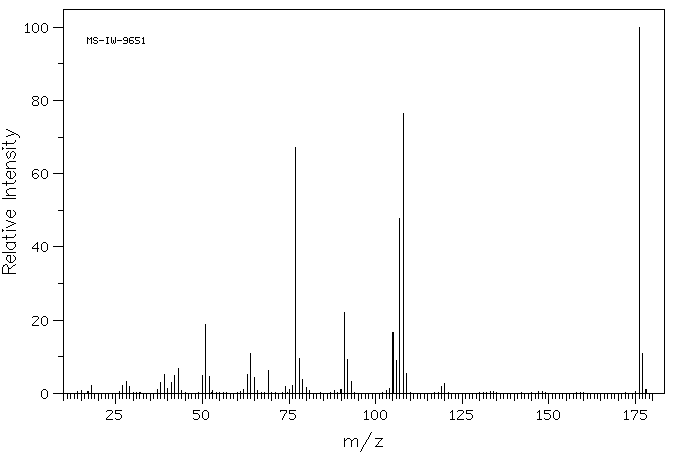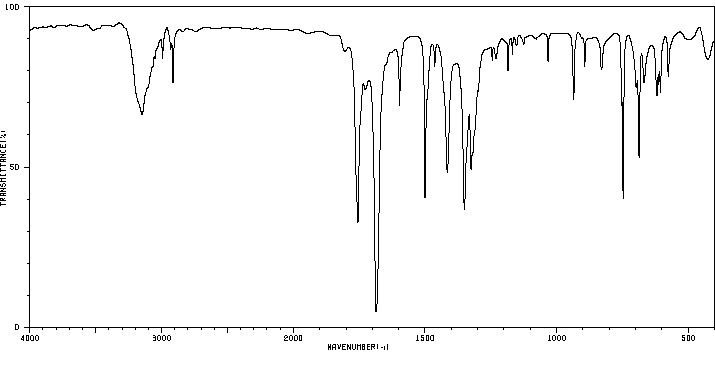3H-Pyrazol-3-one, 1,2-dihydro-5-hydroxy-1-phenyl- | 4072-31-5
中文名称
——
中文别名
——
英文名称
3H-Pyrazol-3-one, 1,2-dihydro-5-hydroxy-1-phenyl-
英文别名
3-hydroxy-2-phenyl-1H-pyrazol-5-one
CAS
4072-31-5
化学式
C9H8N2O2
mdl
——
分子量
176.175
InChiKey
TUUGFLAHJMHZFV-UHFFFAOYSA-N
BEILSTEIN
——
EINECS
——
-
物化性质
-
计算性质
-
ADMET
-
安全信息
-
SDS
-
制备方法与用途
-
上下游信息
-
文献信息
-
表征谱图
-
同类化合物
-
相关功能分类
-
相关结构分类
计算性质
-
辛醇/水分配系数(LogP):1.3
-
重原子数:13
-
可旋转键数:1
-
环数:2.0
-
sp3杂化的碳原子比例:0.0
-
拓扑面积:52.6
-
氢给体数:2
-
氢受体数:3
反应信息
-
作为反应物:描述:3H-Pyrazol-3-one, 1,2-dihydro-5-hydroxy-1-phenyl- 在 18-冠醚-6 potassium cyanide 、 三乙胺 作用下, 以 甲苯 为溶剂, 反应 7.0h, 生成 5-Hydroxy-2,4-bis-(4-methyl-benzoyl)-1-phenyl-1,2-dihydro-pyrazol-3-one参考文献:名称:Synthesis of Tricarbonylmethane Derivatives of Pyridines, Pyrimidines, Pyridazines, and Pyrazoles by Anionic ortho-Fries Rearrangement摘要:Heterocyclic 1,3-dicarbonyl systems, such as 4-hydroxy-2-pyridones, 6-hydroxy-4-pyrimidones, and 5-hydroxy-1-phenyl-3-pyrazolones, are converted with a number of aromatic acid chlorides to their enol esters which can be rearranged in the presence of KCN, triethylamine, and 18-crown-6 as catalyst to yield heterocyclic aryl ketones. This reaction can also be performed in a one-pot procedure without isolation of the esters. Aryl esters of 5-hydroxy-3-pyridazinone can be prepared in the same manner, but not be rearranged.DOI:10.1007/pl00013495
文献信息
-
Sulfenylation of heterocyclic 1,3-dicarbonyl systems: 4-Hydroxy-2-pyrones, 6-hydroxy-4-pyrimidones, 4-hydroxy-2-pyridones, 4-hydroxy-6-pyridazinones, and 5-hydroxy-3-pyrazolones作者:Barbara Schnell、Thomas KappeDOI:10.1002/jhet.5570370439日期:2000.7compounds 1, 9,14, and 19, react in dimethylformamide in the presence of potassium carbonate with diaryl disulfides 2 to yield arylsulfenyl derivatives (3, 10, 15, 20). The arylthiolate anions 4 formed in this reaction can be oxidized by air to yield the starting disulfides 2 again. Tetraalkylthiuram disulfides 7 react in the same manner to yield dialkylaminothiocarbonylthio derivatives (8, 13, 18) of the title
-
ESANU, A.作者:ESANU, A.DOI:——日期:——
-
US4256902A申请人:——公开号:US4256902A公开(公告)日:1981-03-17
-
US4459294A申请人:——公开号:US4459294A公开(公告)日:1984-07-10
-
US4492690A申请人:——公开号:US4492690A公开(公告)日:1985-01-08
表征谱图
-
氢谱1HNMR
-
质谱MS
-
碳谱13CNMR
-
红外IR
-
拉曼Raman
-
峰位数据
-
峰位匹配
-
表征信息
同类化合物
(SP-4-1)-二氯双(1-苯基-1H-咪唑-κN3)-钯
(5aS,6R,9S,9aR)-5a,6,7,8,9,9a-六氢-6,11,11-三甲基-2-(2,3,4,5,6-五氟苯基)-6,9-甲基-4H-[1,2,4]三唑[3,4-c][1,4]苯并恶嗪四氟硼酸酯
(5-氨基-1,3,4-噻二唑-2-基)甲醇
齐墩果-2,12-二烯[2,3-d]异恶唑-28-酸
黄曲霉毒素H1
高效液相卡套柱
非昔硝唑
非布索坦杂质Z19
非布索坦杂质T
非布索坦杂质K
非布索坦杂质E
非布索坦杂质D
非布索坦杂质67
非布索坦杂质65
非布索坦杂质64
非布索坦杂质61
非布索坦代谢物67M-4
非布索坦代谢物67M-2
非布索坦代谢物 67M-1
非布索坦-D9
非布索坦
非唑拉明
雷非那酮-d7
雷西那德杂质2
雷西纳德杂质L
雷西纳德杂质H
雷西纳德杂质B
雷西纳德
雷西奈德杂质
阿西司特
阿莫奈韦
阿考替胺杂质9
阿米苯唑
阿米特罗13C2,15N2
阿瑞匹坦杂质
阿格列扎
阿扎司特
阿尔吡登
阿塔鲁伦中间体
阿培利司N-1
阿哌沙班杂质26
阿哌沙班杂质15
阿可替尼
阿作莫兰
阿佐塞米
镁(2+)(Z)-4'-羟基-3'-甲氧基肉桂酸酯
锌1,2-二甲基咪唑二氯化物
锌(II)(苯甲醇)(四苯基卟啉)
锌(II)(正丁醇)(四苯基卟啉)
锌(II)(异丁醇)(四苯基卟啉)








